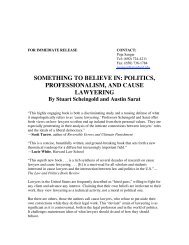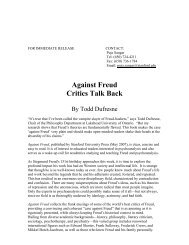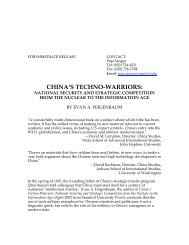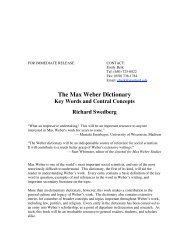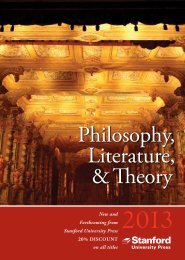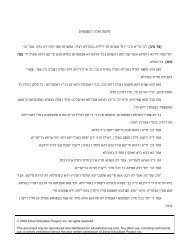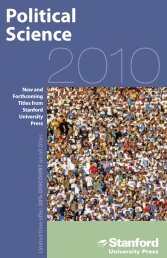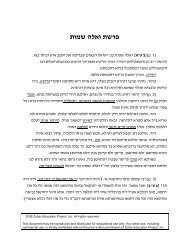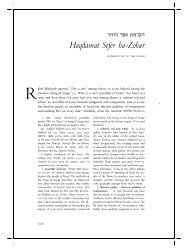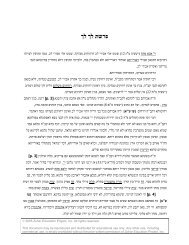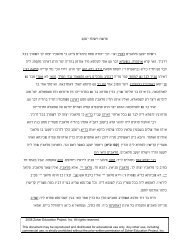Front Matter (PDF) - Stanford University Press
Front Matter (PDF) - Stanford University Press
Front Matter (PDF) - Stanford University Press
Create successful ePaper yourself
Turn your PDF publications into a flip-book with our unique Google optimized e-Paper software.
is this exile that the kabbalists are actingout in their wanderings through<br />
It<br />
Galilee of their imagination. In this sense, it may indeed be said that the<br />
the<br />
in its entirety is a symbolic work, not just a collection of symbolic interpretations<br />
Zohar<br />
of Scripture, The narratives themselves may be seen as the most<br />
symbolic and ``kabbalistic'' part of the Zohar's oeuvre, not just a<br />
profoundly<br />
into which the homilies are woven.<br />
framework<br />
discussion to this point leads us now to confront the question of the<br />
Our<br />
and religious/mystical experience. A ®rst reading of the Zohar might give<br />
Zohar<br />
the impression of a work that is more mythical than mystical in content;<br />
one<br />
more involved with a narrative of cosmic origins and structures than it is<br />
i.e.,<br />
inner experience, the soul, or higher states of consciousness. But this view<br />
with<br />
partially misleading. To read the Zohar well is to fathom the experiential<br />
is<br />
of the entire text, includingnarrative, exegesis, cosmology, and all<br />
dimension<br />
rest. The kabbalist speakingin the se®rotic idiom is layingbare the inner-<br />
the<br />
structure of reality as he both understands and experiences it. That same<br />
most<br />
is re¯ected in the cosmos, in Torah, and in the human (or more<br />
structure<br />
``Jewish'') soul. The language of se®rotic symbolism provides a new<br />
precisely:<br />
through which to see Torah. But the power of that reading, especially as<br />
lens<br />
in the circle of the Zohar, offers more than a hermeneutic. To open<br />
practiced<br />
inner eyes to the new reality created by that pattern of thinkingis to live<br />
one's<br />
the realm of the se®rot themselves. The transformations of language and<br />
within<br />
experience go hand in hand with one another; the breakthrough in con-<br />
inner<br />
to a higher realm of contemplative existence is conveyed through<br />
sciousness<br />
vehicle of self-expression in se®rotic terms. Therefore to speak of the<br />
the<br />
of the se®rotic universe, or to interpret the Torah text in terms of<br />
origins<br />
symbols, is also to enter into those places within the soul. For the<br />
se®rotic<br />
within the Zohar, as for the ideal kabbalist in any time, to speak of<br />
speakers<br />
se®rot is not only to draw on a body of esoteric knowledge, but is also to<br />
the<br />
the inner universe where se®rotic language is the guide to measured<br />
enter<br />
experience.<br />
authors of the Zohar do not generally feel the need to tell their readers<br />
The<br />
this is the case. In a work written for initiates, the link between the<br />
that<br />
and experiential dimensions was taken for granted. It is primarily<br />
intellectual<br />
frequent expressions of enthusiasm and ecstasy with which the text is<br />
the<br />
that serve to indicate how deeply and personally the se®rotic teachings<br />
dotted<br />
felt. The repeated refrain ``Had I come into the world only to hear this, it<br />
were<br />
be suf®cient!'' and the kisses showered upon speakers by their grateful<br />
would<br />
make it clear to any but the most obtuse of readers that in the<br />
companions<br />
of the Zohar we are witnessingthe shared inner life of a vital mystical<br />
pages<br />
and not merely a series of exercises in biblical homiletics.<br />
circle<br />
Introduction<br />
VIII<br />
lxv



